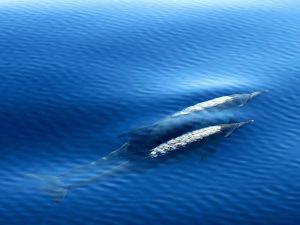Since 2004, Futurismo has been present in Pico Island. Since then, whale watching and swimming with dolphins tours have been run around the island, although not continuously. During the last two years, our seasonal activity became more consistent, allowing us to record more standardised and useful data about cetacean occurrence around the island.
Our new base is located on the South coast of the island at the council of Lajes do Pico. There, you will encounter our zodiac, called Alfredo Baleeiro to honour one of the whaling lookouts, which carries up to 16 people onboard. You can join us from early Spring to early Autumn, to explore this beautiful Ocean that surrounds us.
The analysis of the cetacean observations we made last season (April-October 2018) is already done and from it we have been able to denote some parities with the island of São Miguel. Along these 7 months, we saw 17 of the 28 total species described to date for the Azorean archipelago (Fig. 1 & 2). The 17 species can be classified as resident, which have been observed quite regularly, migratory such as baleen whales and also migratory such as pilot whales and spotted dolphins that come only to stay for the warm months.

The most sighted species was the Risso’s dolphin. This unusual opportunistic feeder dolphin is already well-known by Pico’s fishermen who call it ‘the miller’ (“moleiro” in Portuguese) as they are born of a brownish gray color that will be partially replaced by white scars throughout their life; or as in the case of males these scars can cover almost completely full parts of their body, making them seem that have been grinding cereals to make flour. As in São Miguel, at Pico island we can also find resident groups of Risso’s that stay throughout most of the year in the area. Probably they can find over here the resources they need for survival. So far, there have been identified as residents three different groups of males and 1 group of females.
Our second most sighted species throughout the season is also a resident one. It is the largest toothed whale, which holds one of the biggest brains in the animal kingdom and emits the highest biological sound (sonar) in our atmosphere, the sperm whale! These two resident species share affinities in their diets as they both feed preferentially on squids, which for now are quite abundant around here, from the twilight to abyssal depths, near the slope of the islands. Also, during summer months, the huge and serene pilot whales –big dolphins that form really stable families- migrate here in large numbers to pass the warm season. Alike our two most abundant residents (sperm whale and Risso’s dolphin), the body of pilot whales are already well adapted to forage squids at high depths surrounded by darkness.
Common dolphins were our third most frequently sighted species. These animals are the most abundant species in the warm and temperate waters of the Atlantic Ocean. They have a small body (biggest males attaining 2,5 m) but form numerous pods in which we could also spot, throughout many of the encounters, associations with striped dolphins.
During Spring months, the great migratory baleen whales arrive here. Most of the individuals travel solitary or in small groups and sometimes accompanied by their young. They come from Atlantic’s warmer and tropical waters where they wintered, calved and reproduced. When the waters start to get warmer, they begin roaming up to the North’s colder waters where they will feed during the not-so-cold summer. In these spring months, from April to June, in 61.7% of the days we went out to the sea we have sight fin whales, 42.55% of them we sighted blue whales and 12.77% sei whales.
After Spring, when water’s temperature got up close to the 20ºC the spotted dolphins arrived. They remain here until the temperatures of the water lower again. Although they stayed only for an average of 5 months (from June to the end of October), they were our fourth most-sighted species throughout all the season.
We must also note the frequent encounters with Sowerby’s beaked whales during the warm months surpassed those of previous years. Other member we sighted of this family of cetaceans, the Ziphiidae family, is the Cuvier’s beaked whale, which nowadays holds the record for the longest and the deepest dive, of 2 hours and 18 minutes at 2,993m. They are quite shy and sound sensitive animals. Most of times, we had encountered them by chance as they were emerging from the water near our boat, or because of their summerly high jumps which can be seen from great distances, sometimes even several individuals jumping at the same time!
Less frequent species here were also sighted, such as the Humpback whales or the Pygmy sperm whale.
These were some of the cetaceans observations we made in 7 months along the south coast of Pico Island, but throughout the season, it was also possible to observe quite a few common turtles and Portuguese man o’ war, mainly during Springtime. We also spotted several species of sharks and rays, including a whale shark and several manta rays that delighted us with their size and serenity, several species of birds, mostly Cory´s shearwater, large schools of fish and many other species that gave us the opportunity to observe them as appeared close to the surface of the sea.
We hope to continue with these great sightings for the 2019 season!









